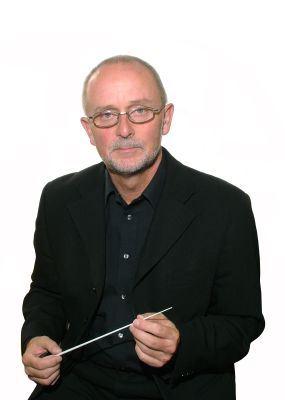|

Youthful Talent
Contemporary music from the Guildhall Brass Band,
enjoyed by MALCOLM MILLER
The City Music Society is one of London's venerable concert institutions, formed in the wash of the flagship National Gallery concerts during World War II. It has continued (unlike those at the national Gallery) as a series for some 64 years, during that period presenting over 200 concerts. The 2007 Winter series of Tuesday Lunchtime concerts at Bishopsgate Hall has featured a range of media, from piano trios to string quartets, to a Baroque Consort (the Saraband Consort) and, for its penultimate event on 30 October 2007, a brass ensemble, the Guildhall Brass Band, conducted by their Director, the trumpeter Paul Cosh. To judge by the sheer size and enthusiasm of the audience, their performance and programme were both outstanding, all the more so as all the works were of recent vintage, from the 1970s, 80s and 90s, and communicated with immediacy and excitement.

Paul Cosh
|
The artfully shaped programme acted as a multi-movement unity, connected by contrasting works concerned to explore textural layering within the brass band. The first, Chromascope, by Paul Patterson, who was present in the audience, is a brilliant display piece composed for the 1974 Harrogate Festival appearance of Besse o' th' barn Brass Band. Here the Guildhall Brass Band were fully alert to its thrilling colours, and dynamic dialogues between sections, firstly in the slow sustained chordal layers spiced with glissandos, dovetailing from high to low, cornets to trombones, and in the second part of the work, with explosive impetus driving forward with effects such as climactic sliding gestures, cascading scales, vigorous rhythmic off beat accents and the like. Patterson created here a mood of energy and splendour which set a bold tone for the rest of the concert. The next work, Philip Wilby's elegiac Shadow Songs (1992), provided an ideal 'slow movement', its subdued muted sonorities and almost atonal clusters for the main group enhancing the character of three main soloistic cameos, intriguingly expressionistic melodies, each remarkably 'shadowed' by a muted partner. The first, for baritone horn, was a symbolic in memoriam to the late horn player David Brunsden, for whom the piece was a tribute; there followed a solos and shadows for trombone and for cornet, with a final eloquent cornet solo.
Continue >>
Copyright © 15 November 2007
Malcolm Miller, London UK

|

